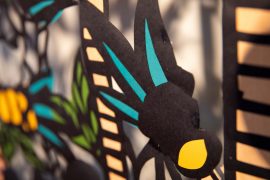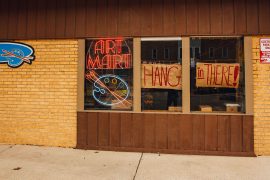Tristan Thompson is the artist behind tristarr.art and has always had his heart set on making a career out of art. PATTERN spoke with the digital illustrator about his inspiration, transition from traditional to digital mediums, and how he recently watched The Little Mermaid for the first time.

Sidney Hoerter: What’s your favorite piece that you’ve worked on thus far?
Tristan Thompson: The piece I did for the Bigger Picture Show, The Little Mermaid piece. It came together so easily. There were a few challenges to it, like there is with every piece. But with that one, every challenge was met. It was executed as one of my best pieces.
Did you go to the Bigger Picture Show? Do you know how it works?
SH: No, I don’t.
TT: Each person creates an artwork based on a movie assigned to them. I got The Little Mermaid for my movie, but I had never seen it.
SH: You’d never seen The Little Mermaid?!
TT: I know, I know! I mean I’m a Disney movie fan, don’t get me wrong, but I had to watch the movie all the way through. I remember I sat down the next day and came up with a sketch instantly. There was no starting over/starting from scratch. My first shot, I nailed it.
SH: How would you describe your style of artwork?
TT: If I could equate it to a genre of music, I would say pop–it’s exaggerated realism. I like to make my work cartoony with exaggerated proportions, but also render it to look dimensional and pop off the page.
SH: What are some artworks/artists that inspire you and your work?
TT: My number one, favorite artist of all time is Frank Frazetta. I remember my dad showed me an art collection of his when I was about eight. Frazetta’s work is a lot of really buff dudes and scantily-clad women.
Me, seeing that at eight, thinking, ‘I want to do that. That’s what I want to do.’
He used all oil paint, but I loved how he was able to tell a story. In every piece, there’s an interaction of the main focus and the viewer or another character in the piece. It doesn’t necessarily have any deeper meaning behind it. You take it at surface value and appreciate it for what it is.
SH: Have you always worked digitally or did you start with traditional mediums?
TT: I started in high school. I remember I only wanted to do pencil drawings my whole life. I was forced to take a painting class in college. When you don’t know how to use it, it’s kind of a messy medium. I thought I would hate it because, in my work, I try to be meticulous. Oil painting forced me to be a little more loose and expressive.
I used oil painting for a couple of years, but then I started working digitally. Whenever you have an opportunity to do freelance, you have to do digital. You need quick turnaround for t-shirt or business design, and oil painting just takes too long for that. I learned a lot of digital on my own. By the time I graduated, that was most of my work; after graduation I just kept with it.
So I would say I started with traditional pencil-to-paper then worked my way into color, oil paints, and, finally, digital. One of the programs I use has a function that simulates oil painting. Digital can replicate it so well without the mess—if you make a mistake, just ‘Ctrl Z’ and you don’t have to use turpentine or anything.
SH: How has Indianapolis influenced your artwork?
TT: I don’t know if it’s necessarily influenced my subject matter, but it has definitely influenced my drive. There’s so many more people here that are driven to create. That motivates me at the same time.
I got into more art shows up here. There’s more artists here than in Evansville, where I’m from. You have to move out of the small town and get up here. That’s how you start meeting other people.
SH: Is there a subject that is just impossible for you to draw or one that you continuously struggle with?
TT: The things that I’m impressed with but would never try to do are detailed patterns. I don’t like to do small geometric shapes. I like to do free-flowing organic stuff. If you think of a mandala with small intricate patterns—that’s the stuff that would make me crazy.
SH: Who is a person that has cheered you on throughout the entirety of your artistic career?
TT: My mom. I get my artistic talent from my dad’s side and they both support me. But my mom is like, ‘Hey, where’s your show this weekend?’ ‘What are you doing? Let me see your piece. Send me your piece!’ She’s almost demanding.
SH: Can you think of a time where you thought you couldn’t make it as an artist?
TT: The time right after you graduate college and you’re about to be thrown into the real world and you think, ‘I need to find a job, like now.’ That time was depressing because I wasn’t getting any clients. I never felt like I couldn’t overcome it, as long as I had my resources. As long as I had money coming in, somehow I could keep working at it. I still feel that way—I need to have a sustainable income to support my art. Art is my number one thing, but I work part-time as a web designer because it makes money. And that money goes to support my art.





